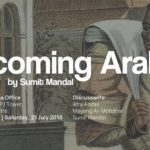Notebook 10, l'enfance de sanbras
2021 - Installation (Installation)
220 x 169 cm
Kelly Sinnapah Mary
Notebook 10 , l ‘enfance de sanbras (The Childhood of Sanbras) series by Kelly Sinnapah Mary is a sequel to an earlier series by the artist titled Cahier d’un non retour au pays natal (2015). This earlier work considers the process of reconstructing an identity of the Indian workers who arrived in the Caribbean during the post-slavery period. The work addresses the conditions of recruitment of these Indian workers, the strategies of the recruiters, how they lured them onto ships to bring them back to the plantations. Inspired by two authors, Aime Cesaire and Khal Torabully, the artist reinterprets masterworks of Caribbean literature. The Childhood of Sanbras series approaches another axis of reflection wherein Sinnapah Mary engages with her experiences and memories as a child, and the characters she identified with, while exploring current stories about the Indian diaspora in the French West Indies. Working with the concept of memory, her notebooks function like diaries in which characters take form and retell a story through drawings and sculptures that refer to a ludic universe of children. The series introduces the stories of Sanbras, a little girl in a school uniform and braids—an element so present in the artist’s practice that serves as a metaphor for the construction of identity through the gesture of braiding. The artist’s narrative mixes elements of Caribbean culture, Maroons, and Hinduism. Sanbras, in some of the works, has extra arms, legs, or a third eye. The little girl meets other friends throughout the story and builds a community. This resilient new village formed by Sanbras is a reference to the Marronage, of which she is part and wishes to build a new ecosystem. In the sculptures that accompany the notebooks, the artist explores Sanbras in a more material and corporeal manner, giving another dimension to the character through an ingenuous naivety.
Kelly Sinnapah Mary is a multidisciplinary artist who’s work is informed by the diasporic journey of her ancestors. She is the descendant of indentured laborers sent from India to Guadeloupe by the French Government in the 19th century to replace the free labor of the transatlantic slave trade. Sinnapah Mary’s practice reflects on her Indo-Caribbean identity by unpacking the details of her ancestors’ middle passage to Guadeloupe. Through the lens of science fiction, she often explores the so-called feminine universe; working with floral themes, soft materials, and fairy tales, using techniques that contrast the poignant and politically charged subject matter she addresses. From this friction, Sinnapah Mary traces her ethnic heritage, while questioning her roots as someone caught in two nested worlds—confronting concepts of ‘negritude’ and ‘coolitude’. ‘Coolie’, an expression coined by Caribbean poet Khal Torabully, is a pejorative name given to Indians who migrated to the Caribbean.
Colors:
Related works sharing similar palette

© » KADIST
Toyin Ojih Odutola
2015As she traces the same shape again and again, Ojih Odutola’s lines become darker and deeper, sometimes pushed to the point where their blackness becomes luminous...

© » KADIST
Sandra Monterroso
2023Presented as part of a recent group of works titled The Paradox of Healing, Rhombus for Healing No...

© » KADIST
Adriana Martínez
2015Her 2015 work Orión is a black flag-like cloth with glow-in-the-dark symbols embroidered in the shape of the constellation...

© » ARTS EQUATOR
Weekly Picks: Malaysia (16 – 22 July 2018) | ArtsEquator Thinking and Talking about Arts and Culture in Southeast Asia Malaysia July 16, 2018 Hua (華) Settler Imaginary in Borneo , at Malaysia Design Archive, 19 July 8pm Academic Dr Zhou Hau Liew presents ‘ Preliminary Thoughts on the Hua Settler Imaginary in Borneo: Cultural Mapping, Revolutionary Communism, and the Ideas of Chineseness ’...

© » SOUTH CHINA MORNING POST
She saves Hong Kong’s neon signs, but it was a Taiwanese mansion that triggered her journey | South China Morning Post Advertisement Advertisement Architecture and design + FOLLOW Get more with my NEWS A personalised news feed of stories that matter to you Learn more Cardin Chan is general manager of Tetra Neon Exchange, which rescues and preserves Hong Kong’s disappearing neon signs...

© » KADIST
Sharon Lockhart
2011Visalia Livestock Market, Visalia, California results from Lockhart’s prolonged investigation of an agricultural center and community...

© » ARTS EQUATOR
Open Call for AE x Goethe-Institut Critical Writing Micro-Residency 2021/2022 | ArtsEquator Thinking and Talking about Arts and Culture in Southeast Asia ArtsEquator Viewpoints March 12, 2021 ArtsEquator and Goethe-Institut Singapore are pleased to announce the launch of the inaugural AE x Goethe-Institut Critical Writing Micro-Residency 2021/2022 ...

© » KADIST
Marcelo Cidade
2006This series of photographs reflects Marcelo Cidade’s incessant walks or drifting through the city and his chance encounters with a certain street poetry like the Surrealists or Situationists before him...

© » HYPERALLERGIC
AI Artwork Projected on Historic Gaudí House Draws Nearly 100K People Skip to content Sofia Crespo, "Structures of Being" (2024), projection mapping at Casa Batlló (photo by Claudia Maurino, courtesy Casa Batlló) BARCELONA — Architect-designer Antoni Gaudí, legend of Catalan Modernisme, is often quoted as having said, “Nothing is invented, for it’s written in nature first.” Whether or not that’s apocryphal, his legacy suggested something holier than human at work...

© » KADIST
Saturday, December 4 at 3 pm at Kadist Visit of the exhibition in the presence of the artists : Kate Mitchell, Ms&Mr and Arin Rungjang Please RSVP: assistant@kadist.org Wednesday, December 8 from 7 to 9pm in the Auditorium of Jeu de Paume “Fabrications: The Theatre of Everyday Life” presented by David Teh and Dougal Phillips “Unreal Asia” a thematic programme originally conceived for the 55th International Short Film Festival Oberhausen 2009...

© » KADIST
Newell Harry
2015(Untitled) Nimoa and Me: Kiriwina Notations by Newell Harry brings together a litany of contemporary politics—mobilization around enduring racism, the legacies of Indigenous and independence struggle, and the prospects of global solidarity against neocolonialism and social injustice...









